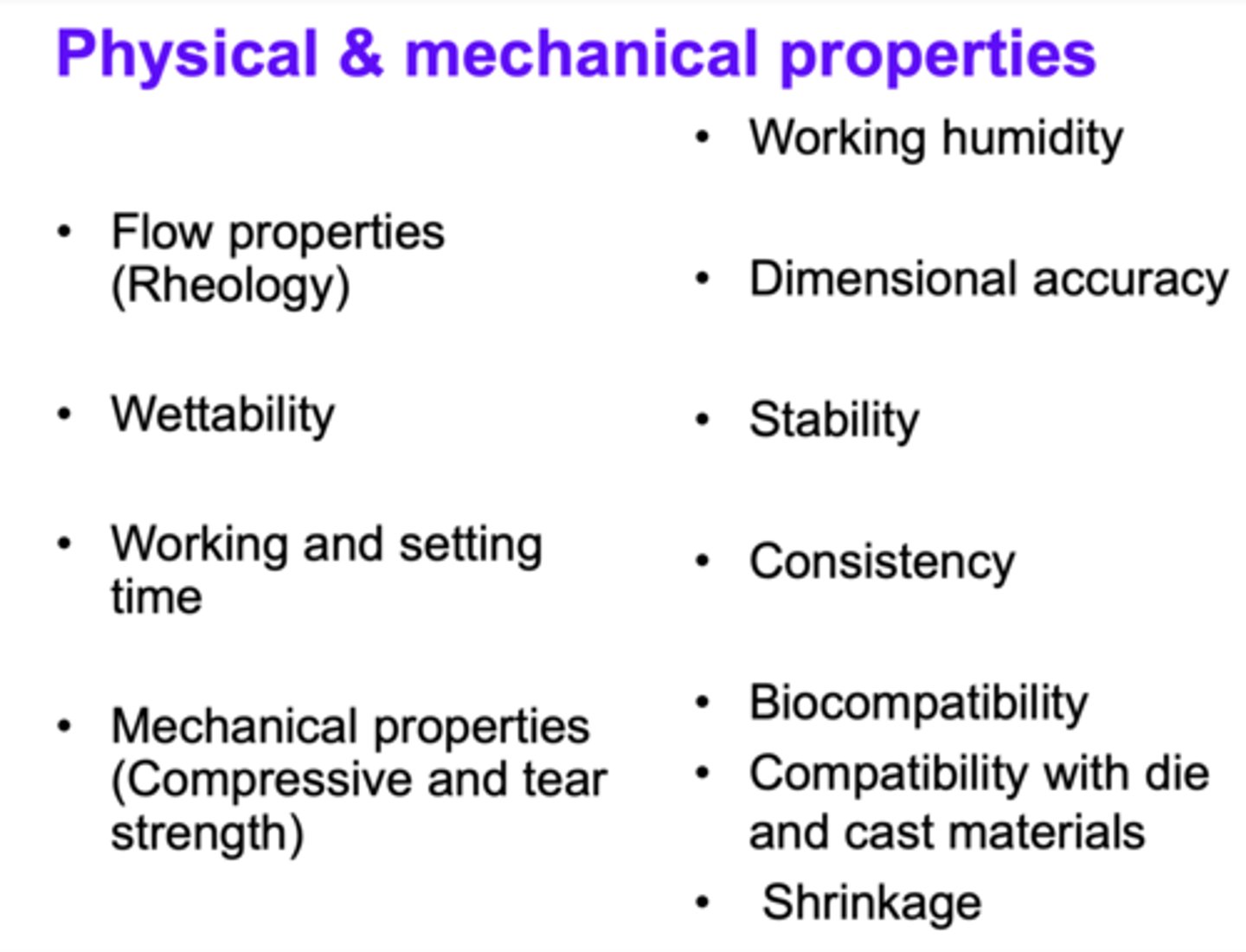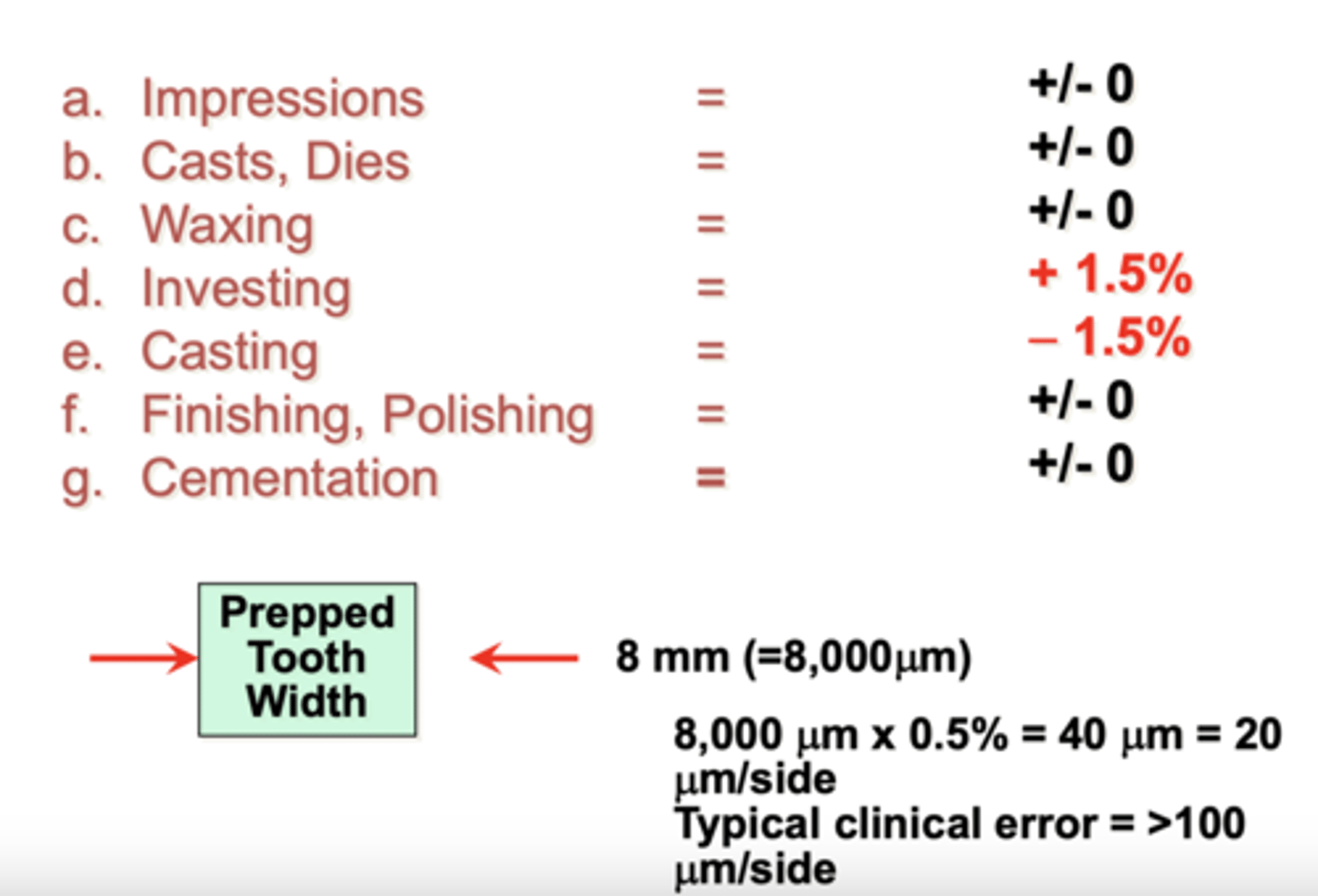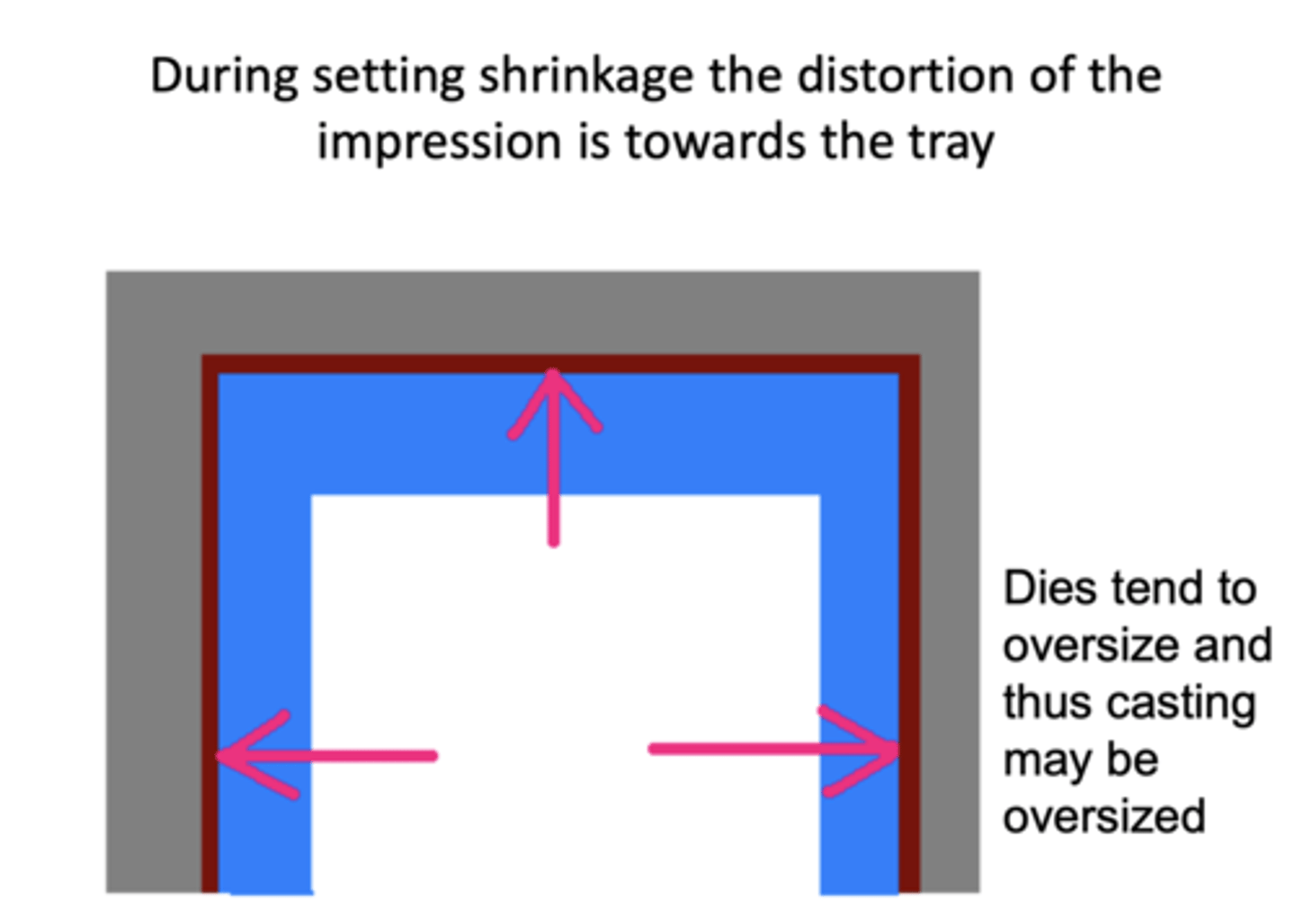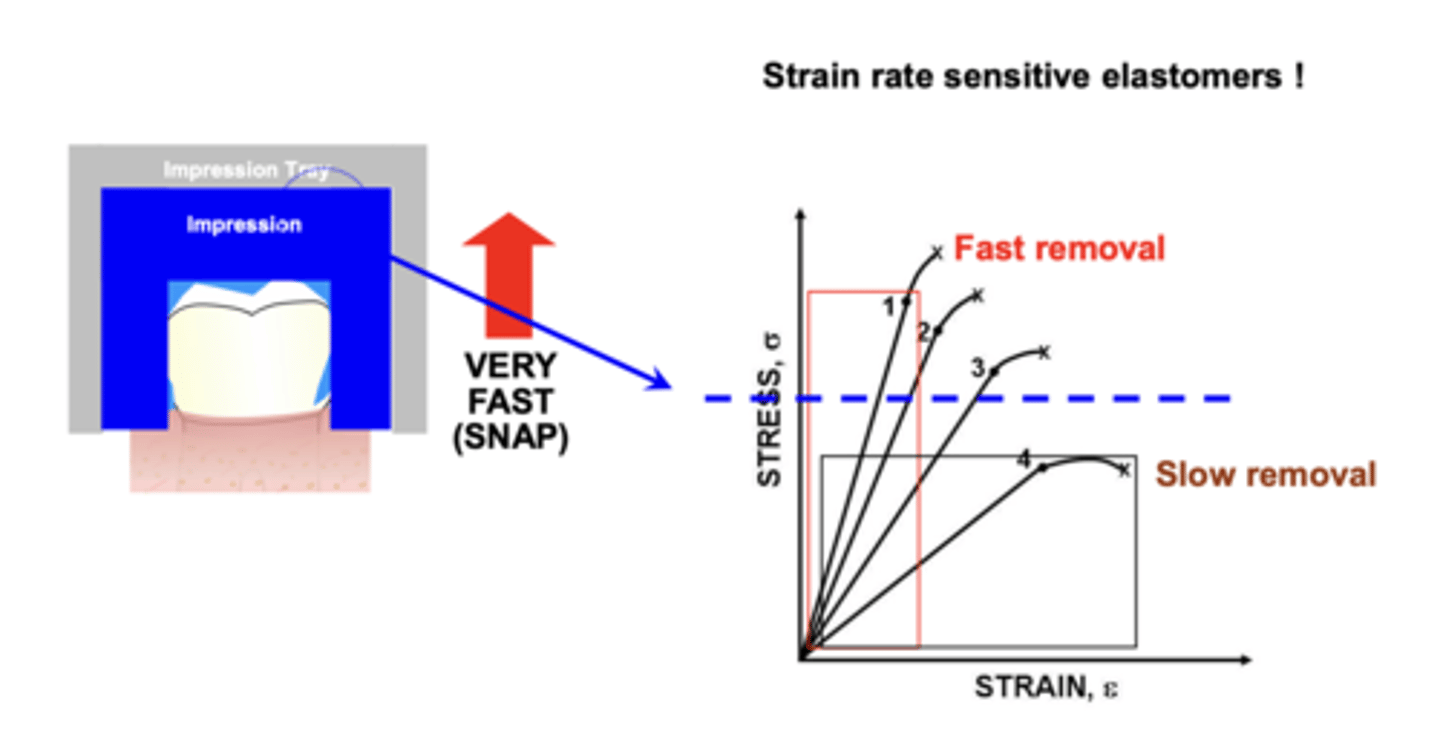Impression Materials: Linking of Labs to Clinics- Biomedicine in Relation to Dentistry III BDS3
1/45
There's no tags or description
Looks like no tags are added yet.
Name | Mastery | Learn | Test | Matching | Spaced |
|---|
No study sessions yet.
46 Terms
How do we fabricate an indirect restoration?
The first step is to record an accurate impression, followed by casting up, investment of the pattern to a mould (lost wax technique) and construction of appliance
When are indirect restorations indicated?
Indicated when there is significantly less natural tooth remaining
Indirect restorations- less intraoral shrinkage
Greater morphology control
Allows use of machined or pressed ceramics
Higher degrees of polymerisation
Cost benefit basis for the patient
What materials do we use for indirect restorations?
Rigid materials:
High modulus of elasticity that can resist high stress without permanent distortion. Many behave as a brittle material
Ceramics: rigid and brittle
Pure gold: ductile
What are impression materials used for?
To record & reproduce the form and relationship of teeth and oral tissues and to record accurate impressions for appliances constructed outside the mouth
What are the 2 types of impression trays?
Stock trays: metals (reusable); polystyrene, nylon (disposable)
Custom trays: disposable
What are the 2 main classifications of impression materials?
1. Elastic materials: synthetic elastomers (e.g. silicones, polyethers); hydrocolloids (e.g. agar, alginates)
2. Non-elastic materials: impression plaster, zinc oxide pastes, impression compound, impression waxes
What are the ideal requirements of impression materials?
Accuracy
Rheological properties
Dimensional stability (short & long term)
Adequate thermal properties
Adherence to tray
Disinfection
Compatibility with model & dye materials
What should the physical & mechanical properties of impression materials be?

What is rheology?
The study of flow or the deformation of materials
It involves the measurement of viscosity and its variation with factors such as shear rate and time
What is the formula for viscosity?
η = shear stress/ shear rate
What does viscosity indicate in simple terms?
The consistency of a fluid
In scientific terms, it is a measure of a fluid's resistance to flow
How do we work out shear stress?
Shear stress = K(shear rate)^n
What is shear thinning?
Applying shear stress to the material (making it thinner), which increases flow and decreases viscosity (pseudoplastic)
What is shear thickening?
When viscosity increases as shear rate increases (dilatant materials)
Describe high/medium/low viscosity.
High viscosity: may not flow over undercuts, but provides a body for the impression
Medium viscosity: flow improves but may not be adequate for very accurate impressions
Low viscosity: Good flow, but still should be moderate otherwise may drip!
Why is wettability an important property to consider for impression materials?
Because you have to consider how it interacts with saliva
If it's hydrophobic: repelled by moisture- you get blow holes
If it's hydrophilic: good flow but may swell on storage
Which type of material is better suited to the oral environment: hydrophilic or hydrophobic?
Hydrophilic materials are more suited to the moist oral environment
However, hydrophilic materials tend to absorb moisture and undergo dimensional changes on storage
What do we mean by accuracy of impression materials?
Their ability to replicate the intraoral surface details
By what two means do impression materials set?
An impression material sets by either
-chemical change
-physical change of state
What does 0.1% shrinkage mean clinically and what are tolerable limits for 'error' in clinical procedures

How can we manage shrinkage?
If you take a heavy body material which has a high filler content, and therefore would contract less, and place it on the tray whilst you cover the tooth with a thin amount of light bodied impression material (so that the material is able to flow), then this will minimise shrinkage
Illustrate the shrinkage that can occur on setting of an impression material.

Why is it recommended to remove an elastomeric impression material from the mouth with a 'snap'?
Because they are strain rate sensitive elastomers

What is the working time?
The amount of time you have to allow proper mixing and dispensing of the impression material in a flowable state when the viscosity of this mix does not rise
What is another factor that affects impression dimension accuracy?
Uniform thickness of impression material- this provides equal dimensional change during setting
What happens if you don't have uniform thickness of impression materials?
Too thick = increased polymerisation shrinkage
Too thin = increased % strain during removal and more viscoelastic flow possible
What is dimensional stability?
On storage the impression should not expand or contract, absorb moisture or dehydrate
A minimum or no change in dimension should occur during storage of the impression
What factors affect dimensional stability?
Continued setting reaction
Slow elastic recovery may continue after withdrawal of the impression
Distortions due to recovery of internal stresses
Loss of volatile components
Uptake of moisture
Why does the coefficient of thermal expansion of the impression material also have an effect on the accuracy of impressions?
Mouth Temperature- 32 to 37 0C
Room temp- 21-25 0C
When the impression material is taken out of the mouth, thermal contraction may lead to inaccurate impressions
How can you minimise thermal contraction?
By having the coefficient of thermal expansion of the material similar to that of the stock tray
What mechanical properties are relevant in terms of impression material?
Resistance to tear
Thin sections should withstand stresses generated during removal of impressions
Tear strength: should be high since external force is applied to remove the impression
Compressive strength: adequate
Why is tear strength an important property for impression materials to have?
Because it's very important for sulcus reproduction and sulcus response so always inspect closely for residual material in the sulcus as impression material remaining in the sulcus can lead to severe periodontal reaction
What are the requirements in terms of biocompatibility for impression materials?
Acceptable taste and odour
Non toxic (no irritation to oral mucosa)
What are the minimum tests that need to be done for an impression material before it can be used in the mouth?
In vitro cytotoxicity
Ames test for mutagenicity
Mucous membrane irritation (Hamster's pouch test)
Sensitisation test (animal models)
Carcinogenicity
What 2 other factors are advantageous for an impression material to have?
Long shelf life
Cheap
What are the currently available delivery systems for impression materials?
Currently available options:
Pad-mix
Automix- less bubbles produced in impression
Syringes- keep diameter narrow to maximise the pseudoplasticity effect
Bulk mixers- for 500ml cartridges
The use of an auto-mix system has been shown to reduce the number of voids in impressions when compared to the traditional pad-mix method and so auto-mixed addition silicone materials are claimed to have excellent properties
What is the best way to mix dilatant, Newtonian, and pseudoplastic materials?
Dilatant & Newtonian fluids are best mixed on mixing pads (eg silicone) whilst pseudoplastics such as polyether and poly vinyl siloxane can be mixed in auto mixing tips
What are some examples of non-elastic impression materials?
Plaster of Paris/Impression plaster
Impression compound
Zinc oxide-eugenol
Impression waxes
What is the main constituent of impression plaster?
Main constituent is calcined ß calcium sulphate hemihydrate and mixing with water yields rigid calcium sulphate dihydrate
How can you reduce expansion on setting of impression plaster?
The addition of potassium sulphate
What does potassium sulphate do?
Potassium sulphate accelerates the reaction thus borax is added to retard the rate of reaction
What are some properties of impression plaster?
Can record fine details, initially has low viscosity, small dimensional changes may occur however the material is very brittle
Why is the treatment of impression plaster before casting a plaster model crucial?
Because otherwise it's impossible to separate the two
What are the properties of the two types of impression compound?
Thermoplastic in nature: Consist of resins such as colophony, shellac, talc as fillers and lubricants (stearic acid)
Type I: Lower fusing materials
-available as thick sheet, can be used for edentulous patients
Type II: Higher fusing materials
-used as tray materials
Describe the composition and function of the two pastes that constitute zinc oxide-eugenol cements.

How do zinc oxide-eugenol cements work and what are its limitations?
Two molecules of eugenol react with zinc oxide to yield zinc eugenolate
Pastes of 1 mm thickness are used to minimize dimensional changes
Major problem is a lack of elasticity
Set material has a tendency to distort or fracture when removed from undercuts